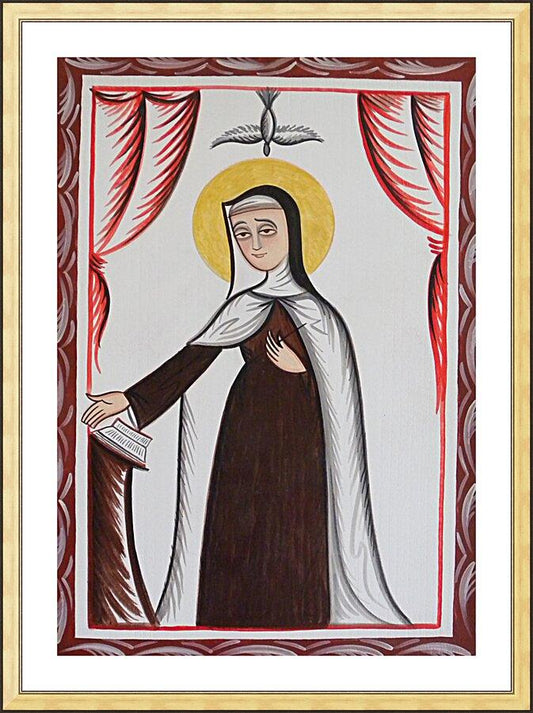Teresa de Cepeda y Ahumada was born in 1515 in Gotarrendura, in the province of Ãvila, Spain. Her paternal grandfather, Juanito de Hernandez, was a marrano (Jewish convert to Christianity) and was condemned by the Spanish Inquisition for allegedly returning to the Jewish faith. Her father, Alonso Sánchez de Cepeda, bought a knighthood and successfully assimilated into Christian society. Teresa's mother, Beatriz de Ahumada y Cuevas, was especially keen to raise her daughter as a pious Christian. Teresa was fascinated by accounts of the lives of the saints, and ran away from home at age seven with her brother Rodrigo to find martyrdom among the Moors. Her uncle stopped them as he was returning to the town, having spotted the two outside the town walls.
When Teresa was 14 her mother died, this resulted in Teresa becoming grief-stricken. This prompted her to embrace a deeper devotion to the Virgin Mary as her spiritual mother. Along with this good resolution, however, she also developed immoderate interests in reading popular fiction (consisting, at that time, mostly of medieval tales of knighthood) and caring for her own appearance. Teresa was sent for her education to the Augustinian nuns at Ãvila.
In the cloister, she suffered greatly from illness. Early in her sickness, she experienced periods of religious ecstasy through the use of the devotional book Tercer abecedario espiritual, translated as the Third Spiritual Alphabet (published in 1527 and written by Francisco de Osuna). This work, following the example of similar writings of medieval mystics, consisted of directions for examinations of conscience and for spiritual self-concentration and inner contemplation (known in mystical nomenclature as oratio recollectionis or oratio mentalis). She also employed other mystical ascetic works such as the Tractatus de oratione et meditatione of Saint Peter of Alcantara, and perhaps many of those upon which Saint Ignatius of Loyola based his Spiritual Exercises and possibly the Spiritual Exercises themselves.
The Ecstasy of Saint Teresa by Bernini, Basilica of Santa Maria della Vittoria, Rome.
She claimed that during her illness she rose from the lowest stage, "recollection", to the "devotions of silence" or even to the "devotions of ecstasy", which was one of perfect union with God (see below). During this final stage, she said she frequently experienced a rich "blessing of tears." As the Catholic distinction between mortal and venial sin became clear to her, she says she came to understand the awful terror of sin and the inherent nature of original sin. She also became conscious of her own natural impotence in confronting sin, and the necessity of absolute subjection to God.
Around 1556, various friends suggested that her newfound knowledge was diabolical, not divine. She began to inflict various tortures and mortifications of the flesh upon herself. But her confessor, the Jesuit Saint Francis Borgia, reassured her of the divine inspiration of her thoughts. On St. Peter's Day in 1559, Teresa became firmly convinced that Jesus Christ presented himself to her in bodily form, though invisible. These visions lasted almost uninterrupted for more than two years. In another vision, a seraph drove the fiery point of a golden lance repeatedly through her heart, causing an ineffable spiritual-bodily pain.
"I saw in his hand a long spear of gold, and at the point there seemed to be a little fire. He appeared to me to be thrusting it at times into my heart, and to pierce my very entrails; when he drew it out, he seemed to draw them out also, and to leave me all on fire with a great love of God. The pain was so great, that it made me moan; and yet so surpassing was the sweetness of this excessive pain, that I could not wish to be rid of it..."
This vision was the inspiration for one of Bernini's most famous works, the Ecstasy of Saint Teresa at Santa Maria della Vittoria in Rome.
The memory of this episode served as an inspiration throughout the rest of her life, and motivated her lifelong imitation of the life and suffering of Jesus, epitomized in the motto usually associated with her: Lord, either let me suffer or let me die.
Born: March 28, 1515 as Teresa Sanchez Cepeda Davila y Ahumada at Avila, Castile, Spain
Died: October 4, 1582 at Alba de Tormes in the arms of her secretary and close friend Blessed Anne of St. Bartholomew; body incorrupt; relics preserved at Alba; her heart shows signs of Transverberation (piercing of the heart)
Beatified: April 24, 1614 by Pope Paul V
Canonized: March 12, 1622 by Pope Gregory XV




















